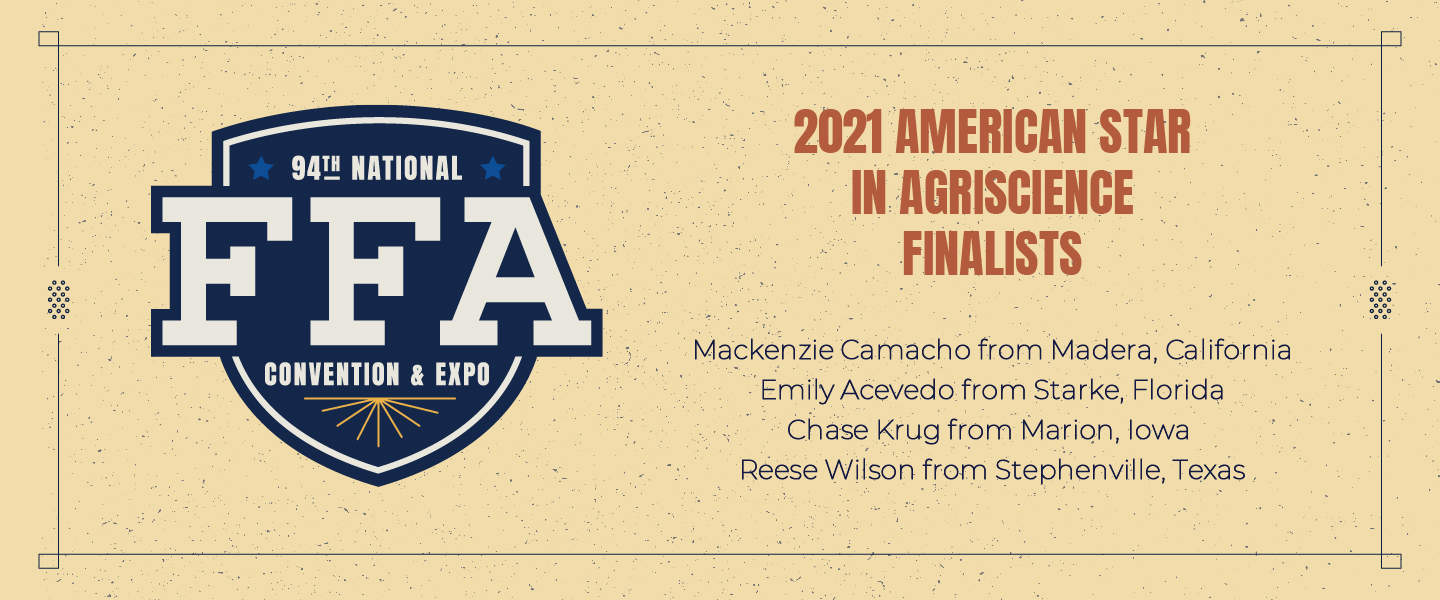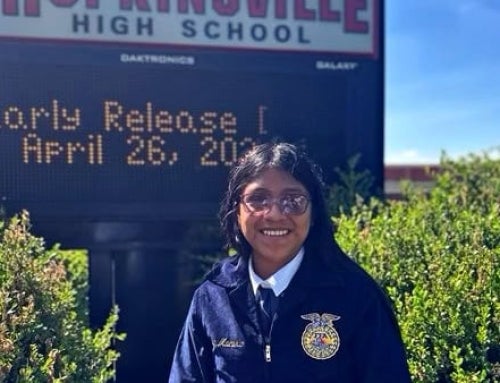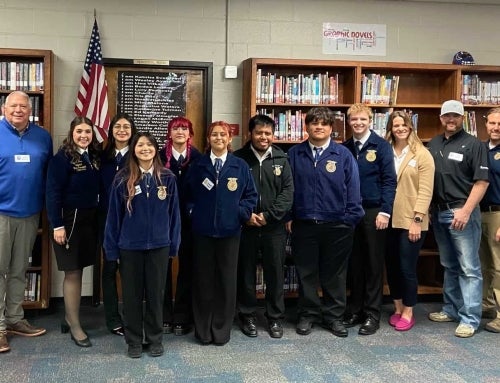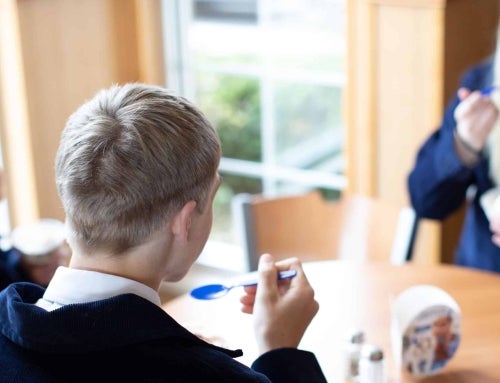Each year at the National FFA Convention & Expo, four FFA members are honored with American Star Awards for outstanding accomplishments in FFA and agricultural education.
The American Star Awards, including American Star Farmer, American Star in Agribusiness, American Star in Agricultural Placement and American Star in Agriscience, are presented to FFA members who demonstrate outstanding agricultural skills and competencies through completion of supervised agricultural experience (SAE). A required activity in FFA, an SAE allows students to learn by doing, by owning or operating an agricultural business, working or serving an internship at an agriculture-based business, or conducting an agriculture-based scientific experiment and reporting results.
Other requirements to achieve the award include demonstrating top management skills; completing key agricultural education, scholastic and leadership requirements; and earning an American FFA Degree, the organization’s highest level of student accomplishment.
The American Star in Agriscience is awarded to the FFA member who demonstrates the top agriscience-based SAE in the nation. Here are the 2021 finalists for American Star in Agricultural Placement:
Mackenzie Camacho, California
A question at a farmers market turned into ample opportunities to research food safety and fungi for Mackenzie Camacho.
Camacho, from O’Neals-Minarets FFA in California, got her start in agriscience after working at a farmers market and wondered how clean fruits and vegetables get from being rinsed in the water bins that vendors were using. She researched and found that rinsing produce in water does not remove a significant amount of the bacteria present. Then, she wanted to continue her work, focusing on an area that could directly impact producers.
“That’s why I ended up talking more directly with the farmers in my community and learned about the fungi that I have worked with for the past three years, finding fungicides and treatment methods or water and burning just the trees, in general, to help the farmers not only in the valley of California but wherever I was able to spread the information through news articles and just word of mouth,” Camacho said.
Her second agriscience project focused on the fungus botryosphaeria, which harms almond and walnut trees. Camacho studied how effective four different fungicides were at reducing the growth of the fungus on walnut trees. In her next study, she observed that when tree branches infected with botryosphaeria were burned, they released fungal spores that could spread. Her research shows that wetting the branches before burning reduces the spread of those spores.
She never expected that her research could impact farmers as significantly as it has.
“But as the years went on and the projects went by, my research got more and more in-depth into the actual problems that farmers are facing with real applications in agriculture,” she said. “It really shows you how much a person can do and how they’re not limited by just being a high schooler.”
Now, Camacho studies civil engineering at Purdue University in Indiana.
“I will potentially work with dams that can help save water and work with farmers at other structures, such as bridges and buildings,” she said. “But, overall, my goal is to take everything I’ve learned in FFA in high school and in college and bring it back to this community.”
Chase Krug, Iowa
An ag science course in Chase Krug’s freshman year of high school introduced him to FFA and led him down a path of agricultural research. He now has over a dozen research projects and an international research experience under his belt.
“I’m originally from a suburban background, so I’ve never had formal experience in agriculture through my family,” he said.
Krug, from Linn-Mar FFA in Iowa, says while his research has varied, he’s focused primarily on plant science and plant breeding. One of his favorite agriscience experiences took place on the other side of the world.
“I was able to be an intern at the World Vegetable Center in Hyderabad, India,” he said. “I lived in India for a summer and got to do international research with great professionals from around the world.”
The research Krug did in India concerned bruchid beetles, which eat mung beans in storage. He looked at what biomolecules in mung beans prevent bruchid beetles from eating them.
“That was a really great experience, and it really shows the impact of taking your research and having an applied component that helps someone instead of doing research just to fill our gap of knowledge. It also contributes to the betterment of society directly,” he said.
Through his other research experiences, Krug has studied soybean drought tolerance, potatoes bred to resist Colorado potato beetles, the idea of cultivating Andean tuber crops in Lesotho and more. Reflecting on his FFA career, he said learning how to do research in his ag classes and developing his leadership skills through FFA helped prepare him for a career in scientific research.
Right now, Krug is a student at Iowa State University, studying philosophy and agronomy. His plans include earning a Ph.D. in plant breeding and focusing his work on public gardens.
“That avenue is what I’m looking toward to really impact both my interest in helping the public and educating the public about science and also conducting research to help either farmers, gardeners, or the industry really move forward and become more sustainable,” he said. “I hope one day that I actually create a public garden research institution somewhere in Iowa.”
Emily Acevedo, Florida
Emily Acevedo of Bradford FFA in Florida says her agriscience journey started in the sixth grade when her show goat unexpectedly gave birth at the Florida State Fair.
“I knew she was bred, but I was not aware of how far along she was,” she said. “That really inspired me to take this path of research, but it started with a statement from this tenacious sixth grader that said, ‘We need a pregnancy test that everybody can use. So simple, no wait time, no lag time.'”
She started her first agriscience project, which was a comparison of different goat pregnancy tests. That led her to other research queries in the realm of goat reproduction, like using feed management to control pregnancy toxemia, a condition (much like preeclampsia in humans) that can affect goats and sheep in the last few weeks of pregnancy. Acevedo also created a table measuring progesterone levels in Boer goats’ last 15 days of pregnancy.
“That helps breeders make a more accurate management decision in cases where they might have to induce their does,” she said.
Today, she continues her research on goat pregnancy tests at Mississippi State University, aiming to develop a test that can determine if a goat is within a few days of giving birth by measuring pregnancy-associated glycoprotein.
“Truly, this experience is something that I wouldn’t trade for the world because it has brought me opportunities that I didn’t even know were out there, not only as a young researcher but as an FFA member,” she said.
One lesson Acevedo says she learned from her FFA advisors —one of whom is her mother—is not to give up on something just because it is difficult.
After completing her undergraduate degree, she wants to get a master’s (and possibly a doctorate) in reproductive physiology.
“My end goal is to share this research with the world and make an impact to hopefully close the global food security gap.”
Reese Wilson, Texas
Reese Wilson got his start in agriscience when he was a freshman in high school, generating his research ideas from his experience with livestock and getting support from mentors along the way. Wilson, from Stephenville FFA in Texas, dove into his first agriscience project with a partner, studying ruminal pH levels in sheep.
“For sheep, ruminal pH level is very important in comparison to overall health and weight gain in ruminants,” he said. “We conducted our very first project over that and had a blast doing it. We got to measure ruminal pH levels over a 60-day period and compare them to weight gain in a large sample size.
“Through that research, Wilson and his project partner found that lower protein feeds resulted in lower stomach fluid pH. His ag teacher and a local veterinarian helped make that research possible.
“It really takes a village to accomplish everything that I’ve been able to do, and I couldn’t have done it without anybody that I’ve encountered along the way,” he said.
Wilson’s later projects included measuring rumen nitrate levels to see if that impacted weight gain and surveying livestock breeders for their opinions on reproductive technologies and if those opinions varied between different demographics.
“Overall, the whole process has been a phenomenal, in-depth learning experience from beginning to end,” he said.
Now, Wilson is a student at Texas Tech University, and he works as a research assistant in the university’s meat science department. Along the way, one big insight he had was the role of chemistry in animal science.
“The average person really doesn’t think that there’s as much chemistry that goes into feeding our animals and feeding the world as there really is, and it really took me back and made me think again,” he said. “Now that I’m in college, and I’m getting to take these upper-level classes, I’m seeing it more and more.”
Wilson wants to further his education to become a professor and continue to work on agricultural research.
The American Star Awards are sponsored by Case IH, Elanco Animal Health and Syngenta. For more information on the awards, visit FFA.org.
General convention sessions will air live on RFD-TV and The Cowboy Channel. FFA members and supporters can tune in and watch gavel-to-gavel coverage of the event. To learn more, visit Convention.FFA.org.












